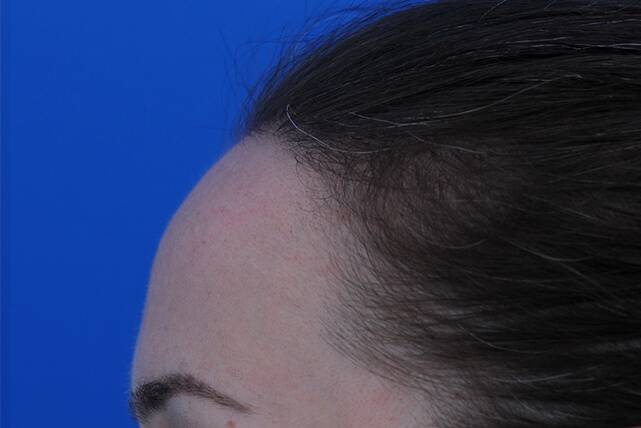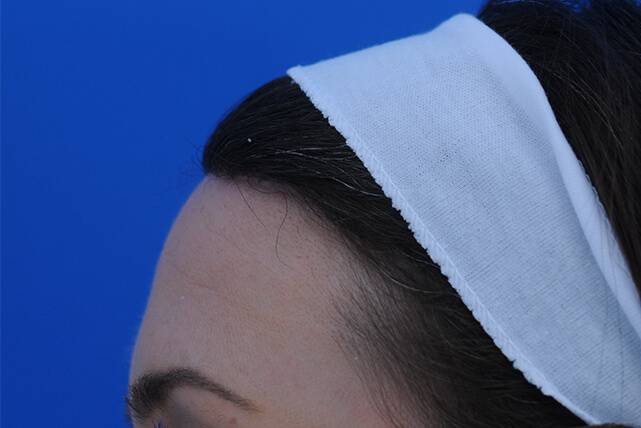All About Hairline Lowering Surgery (Forehead Reduction)

Thousands of men and women across America have over prominent foreheads or receding hairlines. The typical hairline begins anywhere between 5 and 6.5 cm above the eyebrows. Hairlines that start above that point often cause the face to appear aesthetically disproportionate, potentially resulting in difficulty wearing the hair up or off the forehead.
What is hairline lowering surgery?
Hairline lowering surgery, also referred to as forehead reduction, is a highly effective way to move the hairline to a natural level. This surgical technique can effectively lower the hairline by up to 2 inches. The exact amount of modification possible will be determined by how loose a patient’s scalp is during a consultation with a board-certified facial plastic surgeon or plastic surgeon.
Before and After Hairline Lowering
How is hairline lowering surgery performed?
Hairline lowering is a surgical outpatient procedure typically performed using the combination of twilight anesthesia and a local anesthetic. The procedure begins with the surgeon marking the anticipated post-procedure hairline. Next the excess skin between the current and future hairlines is surgically excised and the hair-bearing scalp is advanced to the new hairline. The scalp is then secured into its new location using dissolvable bone anchors or bone tunnels into the skull. The procedure is completed with the incisions being closed using 2 layers of sutures. Additionally, a hair grafting procedure like FUE hair transplant surgery can be used alongside hairline lowering surgery to change the shape of the hairline. For example, the hairline can be moved forward and additional hair can be transplanted to the side regions to create a more round appearance.
Is there permanent scarring?
While scarring should be expected from the procedure, a skilled surgeon can minimize its visibility. Many of the incisions made during the procedure can be placed slightly behind the future hairline, allowing them to cover with the hair. The incisions are not made in straight lines, but usually involve S- or V-shaped curves that break them up and help to hide them. Additionally, incisions can be made in a way that allow hair to regrow through and in front of the scar further reducing its visibility.
How long does the procedure take?
While each individual procedure is different, hairline lowering treatments typically take between 2 and3 hours to complete.
Who is a good candidate for hairline lowering surgery?
Men and women who have a naturally high hairline or large forehead and otherwise thick hair, as well as no personal or familial history of hair loss, are great candidates for hairline lowering surgery. All potential patients should be in good overall health and refrain from smoking for one month before and after the procedure.
Scalp laxity is extremely important to the success of any forehead reduction procedure. During your pre-operative consultation, a detailed pitch test will be performed to help decide whether you will be a good candidate for surgery.
What are other risks of hairline lowering surgery?
Hematoma, or a collection of blood underneath the scalp, is the most common complication with an incidence of about 5%. Infection is rare. Antibiotics are given intraoperatively and may be prescribed for one week after the surgery.
Numbness of the scalp from the incision to the vertex is expected and often resolves, but may take as long as one year in some patients. A rare patient will experience permanent numbness.
Sometimes, the scar is still slightly visible and may be further camouflaged by micro-follicular hair transplants into it.
What should I expect after hairline lowering surgery?
Post-procedure, many patients will experience some pain which can be controlled using prescribed pain medication. Moderate swelling along the forehead, scalp, eye, and cheek areas is common. Much of this swelling diminishes after the first few days, with all swelling fully resolving in a couple of weeks. Bruising is expected but will resolve without intervention within 10 days. By following our diet and perioperative instructions, swelling and bruising will resolve more quickly. Patients can return to work and light activity after 7 days from the procedure, using a scarf or loose fitting hat to cover the area. The sutures placed in the hairline are removed after one week. Patients may do a full workout and fly 2 weeks after the surgery. Often there is global hair thinning of the whole scalp after the surgery (called “shock alopecia”) that can last 3 months. Then 3 to 6 months after the procedure hair regrows through and in front of the incision site, camouflaging the area and making it imperceptible.
Disclaimer: The contents of the Westlake Dermatology website, including text, graphics, and images, are for informational purposes only and are not intended to substitute for direct medical advice from your physician or other qualified professional.
 Before
Before  After
After 
I would like to reduce my hair line lower
Hi Aaron, Thanks for reading our post. Please contact us today to get a free evaluation!
Price range?
Hi Anna, This hairline lowering is one of those procedures where total procedure cost varies greatly based on the needs of the patient. Real Self is probably one of the best places to get a feel for “average” pricing. In Austin, patients reported a range from $4,850 – $13,00 (https://www.realself.com/Forehead-Reduction/cost/Texas/Austin).
As always, you will need to get an in-person consultation to be sure of the exact cost of the procedure you will need. Please feel free to contact us if you would like to schedule a free consultation!
Thanks,
WD Staff
Thanks for sharing this information regarding hairline lowering surgery. My nurses have been showing it to our patients and they have said it has been very helpful. Just wanted to give you some feedback and say good work 🙂
How do I go about finding the right surgeon for this procedure
Hi Demetrius,
Thanks for reading our post and submitting your comment. Obviously we think we’re a great fit for this procedure! Specifically Dr. Constantindes specialized in hairline lowering procedures. If you are in the Austin area please give us a call at 512.615.2730 to setup a free consultation!
Otherwise we recommend doing your research online. Just make sure you choose a board certified surgeon with experience in this specific procedure.
Thanks again
WD Staff
Do you offer payment plans for this procedure?
Hi Jasmine,
We do offer no interest financing for this procedure. For more information on financing options please see this page (https://www.westlakedermatology.com/resources/financing/) or give us a call at 512.328.3376.
Thanks,
WD Staff
How old do you have to be to get this surgery?
Hi Xaile,
Thanks for reading our post and submitting your great question! Most surgeons would recommend waiting until our mid-20’s before considering a hairline lowering procedure. This is due to potential facial structure changes that can occur before that age. However, its always good to see a surgeon for an in-person assessment. Every individual is different and patients under that age may be good candidates if certain characteristics are apparent.
We hope that helps!
Thanks,
WD Staff
Hi!
Do you do virtual consultations or video consultations if I want to consider this procedure with you but states away?
Thank you!
Hello, is the scar visible after 1 year ?
Hi Ameni,
Great question! This all depends upon the specific technique performed, as well as characteristics of each individual patient’s skin. In most cases, any remaining scarring after a year is faint and not very obvious. However, it is always a good idea to discuss the potential for scarring with your surgeon before surgery.
There are also many great scar revision (correction) treatments that can be performed to minimize the appearance of any resulting scars. Here is more info on that: https://www.westlakedermatology.com/blog/scar-removal/
We hope that helps!
Thanks,
WD Staff
I wasn’t aware that scalp laxity is extremely important for forehead reduction. I have patchy skin at the crown of my head. I’ll have to consider getting a scalp treatment to make sure that my scalp is balanced.
Will u be able to do physical activities like boxing and MMA after
Hi Scab,
Great question! I spoke with Dr. Constantinides about this and here is his feedback:
Once fully healed, you should be able to do as vigorous activities as you like. Keep in mind that scars are never as strong as un-operated skin, so a violent blow may open the incision. The risk of this lessens the longer you are from the surgery.
We hope that helps!
Thanks,
WD Staff